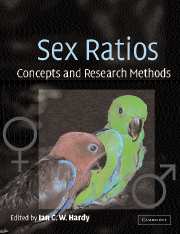Book contents
- Frontmatter
- Contents
- List of contributors
- Preface and acknowledgements
- Part 1 Sex ratio theory
- Part 2 Statistical analysis of sex ratio data
- Chapter 3 Statistical analysis of sex ratios: an introduction
- Chapter 4 Analysis of sex ratios in social insects
- Chapter 5 Analysis of sex ratio variances and sequences of sex allocation
- Chapter 6 Comparative analysis of sex ratios
- Part 3 Genetics of sex ratio and sex determination
- Part 4 Animal sex ratios under different life-histories
- Part 5 Sex ratios in plants and protozoa
- Part 6 Applications of sex ratios
- Index
- References
Chapter 6 - Comparative analysis of sex ratios
Published online by Cambridge University Press: 06 August 2009
- Frontmatter
- Contents
- List of contributors
- Preface and acknowledgements
- Part 1 Sex ratio theory
- Part 2 Statistical analysis of sex ratio data
- Chapter 3 Statistical analysis of sex ratios: an introduction
- Chapter 4 Analysis of sex ratios in social insects
- Chapter 5 Analysis of sex ratio variances and sequences of sex allocation
- Chapter 6 Comparative analysis of sex ratios
- Part 3 Genetics of sex ratio and sex determination
- Part 4 Animal sex ratios under different life-histories
- Part 5 Sex ratios in plants and protozoa
- Part 6 Applications of sex ratios
- Index
- References
Summary
Summary
Comparative studies use the characteristics of different taxa as a source of data, and such studies have made important contributions towards the understanding of sex ratios. Comparative data require special methods for statistical analysis because not all the variance in taxon characteristics is evolutionarily independent. Solving this problem requires explicit phylogenetic and evolutionary assumptions that create challenges at each stage of a comparative study. Here we review the essentials of a comparative approach: asking questions, collecting data, choosing methods, analysing data and drawing conclusions. We include a worked example of a recent sex ratio study on New World nonpollinating fig wasps (West & Herre 1998a), which we analyse using phylogenetically independent contrasts and by simulation methods. Finally we review the relevant software for comparative analysis of sex ratios and how to obtain it.
Introduction
I find that in Great Britain there are 32 indigenous trees[:] of these 19 or more than half … have their sexes separated, – an enormous proportion compared with the remainder of the British flora: nor is this wholly owing to a chance coincidence in some one family having many trees and having a tendency to separated sexes: for the 32 trees belong to nine families and the trees with separate sexes to five families.
Charles Darwin, from Stauffer (ed) (1975).In recent years an abundance of reviews has dealt with the theoretical problems of conducting a comparative study (Ridley 1983, Brooks & McLennan 1991, Harvey & Pagel 1991, Martins 1996a, Pagel 1999).
- Type
- Chapter
- Information
- Sex RatiosConcepts and Research Methods, pp. 132 - 156Publisher: Cambridge University PressPrint publication year: 2002
References
- 14
- Cited by



